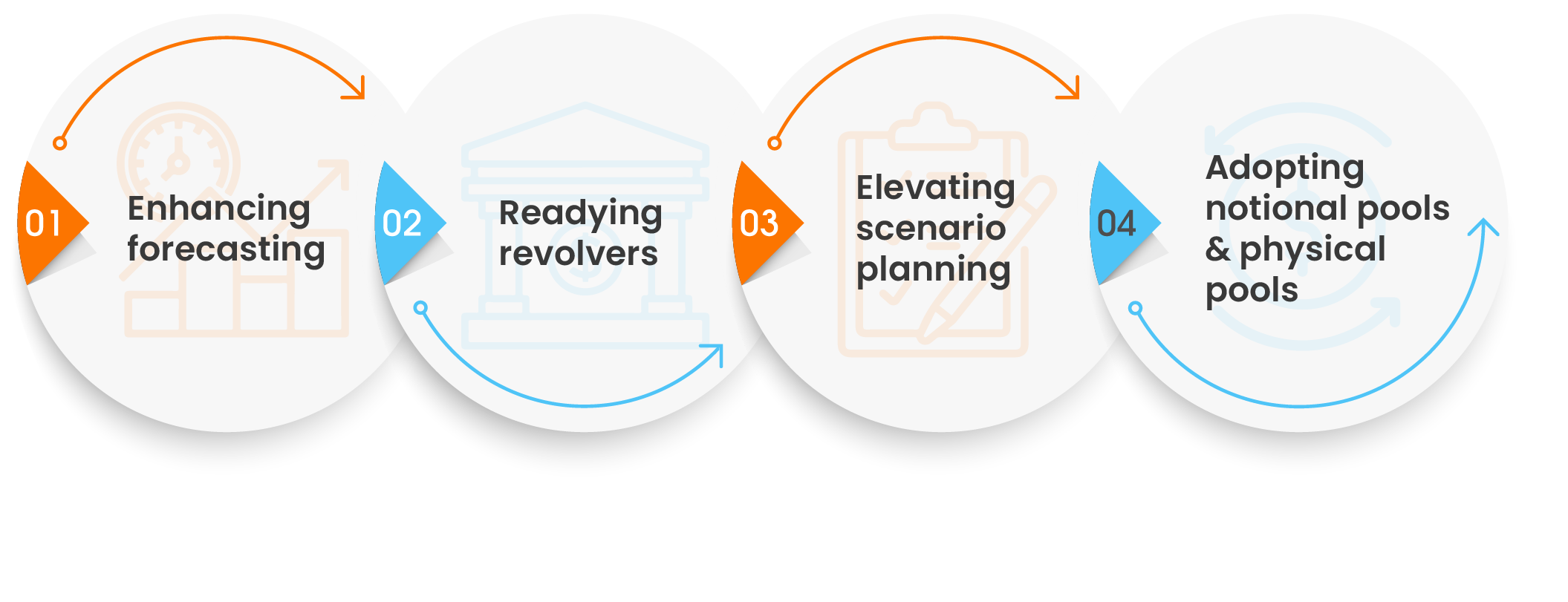How mid-markets can master liquidity management using cash flow management tools
Read this ebook to understand how mid-market companies can use cash flow management tools to improve their liquidity.
Why is liquidity management important for mid-markets?
A corporation can access cash when and where it is required to meet its short-term financial obligations through various strategies, procedures, and tools known as liquidity management.
Ineffective liquidity structures can prevent corporate treasurers from achieving optimal liquidity management domestically and across currencies and borders in this uncertain yet competitive market environment. Inefficiencies, at a minimum, result in additional borrowing, additional transactional costs, and higher-than-necessary expenses, which can be avoided with the use of cash flow management tools.
Key challenges for treasurers in liquidity management
According to a recent IDC poll of more than 800 corporate finance professionals and practitioners, more firms must implement a cohesive and “unified” liquidity management plan using cash flow management tools. The poll was designed to investigate the growing importance that treasurers and other finance professionals place on liquidity management during times of crisis and to capitalize on chances for growth. The study results emphasize the importance of CFOs, treasurers, and other financial professionals developing and implementing strategic efforts to manage liquidity holistically.
According to the survey, the following are the major concerns for treasurers and other financial leaders that are driving this heightened urgency for effective liquidity management:
- Inadequate communication of critical treasury/financial KPIs to key stakeholders
- Managing revenue leakage points, such as fraud and payment optimization
- Managing ever-changing regulatory requirements
- Struggling with real-time cash forecasting and liquidity visibility
- Not handling liquidity management in a unified approach
How to manage liquidity in times of market volatility?

01. Enhancing forecasting
Early in the pandemic, treasury leaders were compelled to update liquidity forecasts more frequently due to business closures, staffing issues, risks relating to customers’ payment timing and solvency, and other uncertainties. Although markets began to improve, supply-chain issues increased many companies’ cash needs.
To accomplish this effectively, treasurers should develop an integrated, highly automated process incorporating data from different business stakeholder groups, such as supply chain and FP&A [financial planning and analysis]. They also need to have a clear understanding of the cash flow drivers.
02. Readying revolvers
Corporate revolvers exist to provide needed operating liquidity during times of market or liquidity stress. Every company that does not have excess cash or capital on its balance sheet should have a revolver to bridge the gap during extreme market stress.
03. Elevating scenario planning
Rising interest rates are just one of several factors influencing liquidity management strategies right now. Treasurers must run and plan for multiple scenarios to adapt quickly to changing markets. Furthermore, treasurers must focus on what is most important rather than getting hung up on details that may or may not have a material impact.
04. Adopting notional pools & physical pools
Adopting an automated physical pooling structure with the help of cash flow management software gives a consolidated view of a corporation’s cash position. This automatic cash movement helps:
- lower borrowing costs
- lessen the need for external debt
- maximize interest and working capital
- prevent a liquidity crunch
An automated notional pooling structure also reduces the company’s borrowing costs (and thus total borrowing needs) and aids in the management of cyclical cash flow fluctuations and variations in cash balances and requirements.
Tips on how mid-markets can improve liquidity with business cash flow management tools
When developing effective cash flow management strategies, ensure that you have answers to the following questions:

These are the following tips on how mid-markets can improve liquidity:

What are the benefits of using cash flow management software?
Here are the benefits for which mid-markets should leverage cash flow management software:
- One dashboard for all your finances: Connecting to all bank accounts, loans, and superannuation accounts provides a quick financial overview. The cash management system makes data easily accessible and keeps track of inflows and outflows.
- Categorization of expenses: Organizing expenses into categories makes it easier to manage the business’s finances, create budgets, and decide which costs can be written off against taxable income when filing taxes. Managers and treasury teams can easily modify procedures and regulations using cash management software. Additionally, since every payment request is stored in a single, secure cloud, treasury teams can easily maintain accurate records and quickly access them.
- Budget tracking and cash positioning: The cash flow management software aids in the forecasting of a company’s cash flows over a specified time. This could help maintain a weekly, monthly, quarterly, or annual budget. The budget determines whether the company has enough cash to continue operating for the specified time.
- Time savings: Business cash flow management tools benefit planning and coordination. The software uses RPA and API to gather real-time data from banks and consolidate it into one location, allowing treasurers to save time to concentrate more on strategic and high-priority tasks.
- Improved inter-company lending: Treasurers might not be able to respond to customers on time due to improper record management from a lack of cash flow management software. Collecting data from various departments and keeping track of ongoing collection activities where manual processes are used is challenging. With the aid of business cash flow management tools, all mirrored and notional bank accounts can automatically track balances, record interest, and capture intercompany activities.

